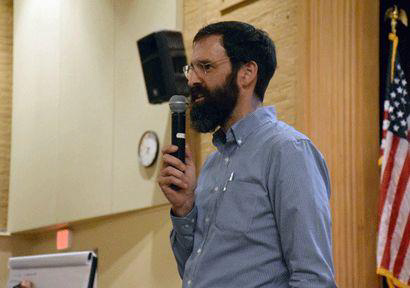
DEC hears comments on Essex Chain future
Adirondack Daily Enterprise
July 8, 2015
By SHAUN KITTLE
NEWCOMB - It's not easy to please everyone, especially when land-use issues are involved.
The state Department of Environmental Conservation held two public meetings this week to accept comments on its proposed plan for the Essex Chain Lakes Management Complex.
DEC senior forester Corrie O'Dea explained that the plan would bolster tourism in nearby towns by including community-connector snowmobile trails, paddling access, and bicycle and horse trails. The connector trails would link the towns of Indian Lake, Minerva, Newcomb, Long Lake and North Hudson. Willie Janeway, executive director of the Adirondack Council,
Willie Janeway, executive director of the Adirondack Council,
speaks in Newcomb during the DEC’s public comment
meeting on the proposed plan for the Essex Chain Lakes
Management Complex on Tuesday.
News photo — Shaun KittleOverall, the 12 people who spoke at the Newcomb meeting applauded the DEC's efforts to consider multiple uses for the land and to consider public input when crafting the plan. Local officials, like Newcomb town supervisor George Canon, praised the DEC's suggested snowmobile connector routes.
There are several possible connector routes on the table, but O'Dea said the agency prefers the one that requires building a bridge over the Cedar River and keeping the Polaris bridge, which spans the Hudson River. Both bridges are controversial.
"Snowmobiling is the major acquisition of this property as far as we're concerned," Canon said. "When the winter months come and the fishing, hiking and camping are reduced, the inter-connectivity we've discussed over the past two years absolutely needs the Cedar and Polaris bridges to make this work."
The Polaris bridge was built in 1992 by the Finch, Pruyn Timber Company.
Those opposed to it insist that it was never intended for public use and is therefore a nonconforming structure, so it should be removed. Those in favor of the bridge challenge the public-use argument and say the communities can't properly be connected without it.
"The Polaris bridge would enable snowmobilers traveling from Indian Lake to cross the Hudson and go on to either Newcomb in the north or Minerva in the east, and again, we support the east-west route on the existing Vanderwhacker trail," said town of North Hudson Supervisor Ron Moore.
Peter Bauer, executive director of the environmental group Protect the Adirondacks, said the proposal for the Polaris and Cedar bridges violates the Wild, Scenic and Recreational Rivers Act, DEC regulations and the State Land Master Plan.
"Widespread violations of existing law, of existing policy, are the hallmark of this plan," Bauer said. "That's really unfortunate because these are extraordinary natural resources."
Bauer also called using existing access roads for snowmobile connector trails "redundant," and said new snowmobile paths crossing the Vanderwhacker Mountain Wild Forest shouldn't be created either.
"Building a 9- to 12-foot wide community connector trail would require taking down thousands of trees, thousands of large trees, tens of thousands of small trees, and complete removal of the understory. Rocks and stumps will be removed; it's graded and excavated with heavy equipment. Hiking trails are not built that way, cross-country ski trails are not built that way, horse trails are not built that way, mountain biking trails, especially what we've seen in Wilmington, 18-inches wide, are not built that way. No other activity in the forest preserve has such a heavy footprint as the Class 2 community connector snowmobile trail."
Willie Janeway, director of the Adirondack Council, praised the DEC for its public approach to constructing its plan, and for its inclusion of mountain biking, snowmobiling and a bridge over the Cedar River, but he also questioned the legality of the Polaris bridge.
"We appreciate those being in the plan," Janeway said. "Those are all possible while protecting the resource, while also making sure we get some of the economic benefits the municipalities want to see."
The DEC's proposed plan would also allow motorized vehicle access to Deer Pond and Fifth Lake, both of which were also questioned.
Bauer said access for people with disabilities should be located on the north side of Fifth Lake, making the existing culvert between Fourth and Fifth lakes unnecessary. He said the culvert should be removed to restore the navigable channel there.
Bauer also said the public parking area that's past the Deer Pond gate should be removed from the plan.
Robert Kafin, vice chairman of the Adirondack Council, agreed that motorized vehicle access should be limited.
"The last thing one would want to do with such a resource is put a corridor through it for motorized recreational or vehicular equipment," Kafin said. "That would fragment its ecological structure, provide new pathways for the introduction of invasive species, and disturb deer and other wildlife. No science-based analysis could support such a misuse of backcountry roads."
Kafin said the towns involved could instead serve as gateways to the lands and provide visitors with amenities like hotels, restaurants, guide services and outdoors outfitters.
The DEC is accepting comments on the Essex Chain Lakes draft unit management plan through July 27.





